
Carnegie Mellon University (CMU) is a private research university in Pittsburgh, Pennsylvania. The institution was originally established in 1900 by Andrew Carnegie as the Carnegie Technical Schools. In 1912, it became the Carnegie Institute of Technology and began granting four-year degrees. In 1967, it became the current-day Carnegie Mellon University through its merger with the Mellon Institute of Industrial Research, founded in 1913 by Andrew Mellon and Richard B. Mellon and formerly a part of the University of Pittsburgh.
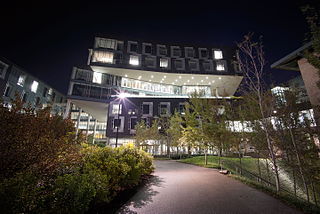
The School of Computer Science (SCS) at Carnegie Mellon University in Pittsburgh, Pennsylvania, US is a school for computer science established in 1988. It has been consistently ranked among the top computer science programs over the decades. As of 2022 U.S. News & World Report ranks the graduate program as tied for second with Stanford University and University of California, Berkeley. It is ranked second in the United States on Computer Science Open Rankings, which combines scores from multiple independent rankings.
The DARPA Grand Challenge is a prize competition for American autonomous vehicles, funded by the Defense Advanced Research Projects Agency, the most prominent research organization of the United States Department of Defense. Congress has authorized DARPA to award cash prizes to further DARPA's mission to sponsor revolutionary, high-payoff research that bridges the gap between fundamental discoveries and military use. The initial DARPA Grand Challenge in 2004 was created to spur the development of technologies needed to create the first fully autonomous ground vehicles capable of completing a substantial off-road course within a limited time. The third event, the DARPA Urban Challenge in 2007, extended the initial Challenge to autonomous operation in a mock urban environment. The 2012 DARPA Robotics Challenge, focused on autonomous emergency-maintenance robots, and new Challenges are still being conceived. The DARPA Subterranean Challenge was tasked with building robotic teams to autonomously map, navigate, and search subterranean environments. Such teams could be useful in exploring hazardous areas and in search and rescue.
A sandstorm is a storm caused by strong wind and sand or dust.

The Robotics Institute (RI) is a division of the School of Computer Science at Carnegie Mellon University in Pittsburgh, Pennsylvania, United States. A June 2014, the article in Robotics Business Review magazine calls it "the world's best robotics research facility" and a "pacesetter in robotics research and education."
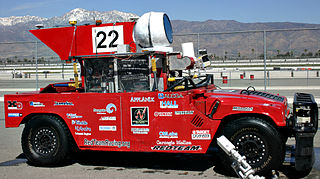
Sandstorm is an autonomous vehicle created by Carnegie Mellon University's Red Team, for the 2004 and 2005 DARPA Grand Challenge competition. It is a heavily modified 1986 M998 HMMWV.

Stanley is an autonomous car created by Stanford University's Stanford Racing Team in cooperation with the Volkswagen Electronics Research Laboratory (ERL). It won the 2005 DARPA Grand Challenge, earning the Stanford Racing Team a $2 million prize.

Sebastian Thrun is a German-American entrepreneur, educator, and computer scientist. He is CEO of Kitty Hawk Corporation, and chairman and co-founder of Udacity. Before that, he was a Google VP and Fellow, a Professor of Computer Science at Stanford University, and before that at Carnegie Mellon University. At Google, he founded Google X and Google's self-driving car team. He is also an adjunct professor at Stanford University and at Georgia Tech.
Crusher is a 13,200-pound (6,000 kg) autonomous off-road Unmanned Ground Combat Vehicle developed by researchers at the Carnegie Mellon University's National Robotics Engineering Center for DARPA. It is a follow-up on the previous Spinner vehicle. DARPA's technical name for the Crusher is Unmanned Ground Combat Vehicle and Perceptor Integration System, and the whole project is known by the acronym UPI, which stands for Unmanned Ground Combat Vehicle PerceptOR Integration.
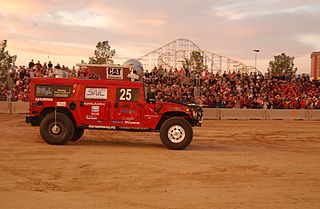
H1ghlander is an autonomous vehicle. Created by Carnegie Mellon University's Red Team, it is a heavily modified 1999 HUMMER H1. It competed in the 2005 DARPA Grand Challenge.

Announced in 2002, the first DARPA Grand Challenge was a driverless car competition held on March 13, 2004 in the Mojave Desert region of the United States. The 150 miles (240 km) route followed Interstate 15 from just before Barstow, California to just past the California-Nevada border in Primm. None of the robot vehicles finished the route. The vehicle of Carnegie Mellon University's Red Team traveled the farthest distance, completing 11.78 km (7.32 mi) of the course. The $1 million prize remained unclaimed.
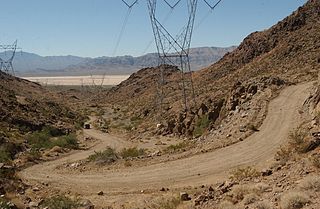
The second driverless car competition of the DARPA Grand Challenge was a 212 km (132 mi) off-road course that began at 6:40 am on October 8, 2005, near the California/Nevada state line. All but one of the 23 finalists in the 2005 race surpassed the 11.78 km (7.32 mi) distance completed by the best vehicle in the 2004 race. Five vehicles successfully completed the course:
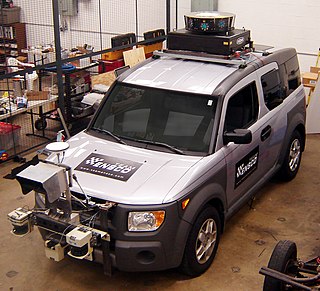
The third driverless car competition of the DARPA Grand Challenge was commonly known as the DARPA Urban Challenge. It took place on November 3, 2007 at the site of the now-closed George Air Force Base, in Victorville, California, in the West of the United States. Discovery's Science channel followed a few of the teams and covered the Urban Challenge in its RobocarsArchived 2008-07-30 at the Wayback Machine series.

Frank Dellaert is a professor in the School of Interactive Computing at the Georgia Institute of Technology. He is also affiliated with the IRIM@GT center and is well known for contributions to Robotics and Computer Vision.
The Learning Applied to Ground Vehicles (LAGR) program, which ran from 2004 until 2008, had the goal of accelerating progress in autonomous, perception-based, off-road navigation in robotic unmanned ground vehicles (UGVs). LAGR was funded by DARPA, a research agency of the United States Department of Defense.
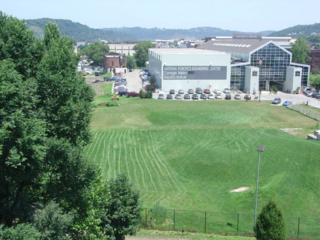
The National Robotics Engineering Center (NREC) is an operating unit within the Robotics Institute (RI) of Carnegie Mellon University. NREC works closely with government and industry clients to apply robotic technologies to real-world processes and products, including unmanned vehicle and platform design, autonomy, sensing and image processing, machine learning, manipulation, and human–robot interaction.
Ragunathan "Raj" Rajkumar is the George Westinghouse Professor of Electrical and Computer Engineering at Carnegie Mellon University in Pittsburgh, Pennsylvania. He is also affiliated with the Robotics Institute and the Heinz School of Information Systems and Public Policy at Carnegie Mellon University. He also serves as the Director of the Metro21 Smart Cities Institute and as the Director of the Mobility21 USDOT National University Transportation Center at Carnegie Mellon University. He also leads the General Motors-CMU Connected and Autonomous Driving Collaborative Research Laboratory (CAD-CRL), and the Real-Time and Multimedia Systems Lab (RTML) there.
Torc Robotics (Torc), an independent subsidiary of Daimler Truck, is an American autonomous truck company headquartered in Blacksburg, Virginia, with operations in Albuquerque, New Mexico; Austin, Texas; and Stuttgart, Germany. Torc is testing autonomous trucks in Virginia, New Mexico, and Texas and is taking a pure play approach to commercialization – focusing at first on one platform in one region.

Chris Urmson is a Canadian engineer, academic, and entrepreneur known for his work on self-driving car technology. He cofounded Aurora Innovation, a company developing self-driving technology, in 2017 and serves as its CEO. Urmson was instrumental in pioneering and advancing the development of self-driving vehicles since the early 2000s.

Maynard Ansley Holliday is the Assistant Secretary of Defense for Critical Technologies in the Office of the Under Secretary of Defense for Research and Engineering. He previously worked under Barack Obama, during which time he launched the Defense Innovation Unit. Holliday was a Project Manager for Pioneer, a robot that helped to map the inside of the Chernobyl Nuclear Power Plant.














